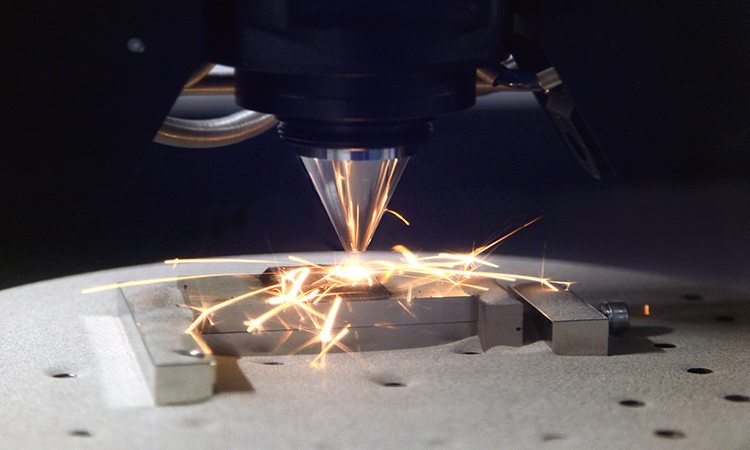Polymer-based 3-D printing has been all the rage, well-known for faster prototyping or novelty items that can be made on the spot, but the world of 3-D printing is about to get a lot more metal.
Many Arizona-based companies, particularly firms in the aerospace and defense industry, have been working night and day to bring metal 3-D printing, or additive manufacturing, parts to market while also gearing up to create a workforce of the future.
In partnership with Arizona’s universities and researchers, the state has the chance to be a leader in this space.
3-D metal printing works by laying down layers of metal powder, which can be as thin as a strand of hair. A thermal source, which could be anything from a laser to an electron beam, will then melt this powder. This process will continue, layer by layer, until a part in any shape is created within the build chamber.
Metal-based 3-D printing can be used to create medical devices and parts for aircraft, cars and boats.
This process is perfect for complex parts that are expensive and time-consuming to machine. By using 3-D printing to make these parts, you can have a more efficient and lighter weight part, which is perfect for the aerospace industry. Also, entire assemblies that consist of dozens of parts can be 3-D printed to make one part.
3-D printing technology is not new. It has been around for decades, but the materials have revolved around plastics for some time. Recent advancements have created fresh opportunities for metal-based 3-D printed items.

Dhruv Bhate Ph.D, associate professor at Arizona State University, studies how materials react. Throughout his career, he has become extremely interested in the metal 3-D printing space. He recently left his job as chief technologist at PADT Inc. to continue research at ASU in this field, while also teaching future engineers the secrets of this emerging world.
Arizona’s aerospace industry is leading the charge of adopting metal additive manufacturing where it works best in order to create lighter parts, while also freeing up ways parts can be designed, Bhate says. At the moment, local aerospace firms like Honeywell are working to get these parts approved for use within airplanes, Bhate says. Both the materials used to make these 3-D parts need to be qualified to fly, as well as the part in its final form. Honeywell has already had the Federal Aviation Administration approve two non-flight critical parts, Bhate explains.
These are relatively low-risk, non-critical parts, but Honeywell is developing a roadmap to further introduce more parts, he says.
And as more roadmaps are created within this space, 3-D printing with metal will only be adopted more, bringing a whole new world of benefits to manufacturers and engineers.
“Where we’re looking at this, going down the road is that we’re looking at replacing 10-, 20-, 30-part assemblies with one part,” Bhate says. “And completely redesigning things like heat exchangers, housing for all kinds of equipment, turbo chargers. And what does that mean? Ultimately, we’ll have lighter components and significant weight reduction. People typically talk about 20 to 50 percent weight reductions for things that fly.”
Come gather and collaborate
Last year, during the Arizona Technology Council’s Aerospace, Aviation & Defense and Manufacturing Conference, there were presentations about metal additive manufacturing, sparking interest from those in attendance.
Arizona Technology Council President and CEO Steven G. Zylstra fielded some questions about whether the Tech Council should coordinate the industry to spur local collaboration between industry partners and the universities.
As a result, a committee was formed, picking two co-chairs, one of which was Dhruv Bhate. During this year’s conference, there was much talk about Arizona’s opportunities within this space from a meeting room at ASU’s SkySong. People were asking, “Could Arizona become a leader?”
“I think there’s a sense that there’s an opportunity here for Arizona to become one of the national leaders in additive manufacturing,” Zylstra says.
Since this committee was formed, the local researchers from ASU and representatives from the firms like Honeywell and Raytheon have been working together to support the local industry. They’ve been doing this by working to create a pipeline of future talent from ASU and by sharing research and ideas in this new space, Zylstra says.
ASU’s Ira A. Fulton Schools of Engineering has been deeply engaged in this space. The school currently has the largest additive manufacturing lab in the Southwest, and Associate Director of Corporate Engagement at the Fulton Schools Malcolm Green has been working with companies to help them find the best application for metal additive manufacturing.
Green says there isn’t a major player in the nation that isn’t utilizing additive manufacturing or at least evaluating this technology in some regards. 3-D printing with metals is a disruptive space, Green notes.
“Additive manufacturing is disruptive to the point where once companies and employees see the potential, then minds start racing about new materials, new blends, new chemistries of products that can be 3-D printed that are stronger and lighter in weight,” Green says.
ASU and its 3-D printing research lab, the Manufacturing Research and Innovation Hub, officially launched last January. Companies have been working with ASU to find applications for this technology, while opening a door for students to work and research in the real world through internships or post-graduation jobs, Green says.
And with more generations of future engineers to work in this space, the more interest from companies to work with ASU will be generated, Green says.
As ASU becomes more popular in this space, the school will be stronger and so will popularity of this technology, he says.
“It goes full circle and provides a stimulus for the economic region,” Green says.
Big changes, big disruptions
It seems the local players who could most benefit from metal 3-D printing are deeply committed to collaborating to find more ways of using this technology in their manufacturing processes.
Titan Industries, which was founded by two former engineers at Orbital ATK, is one of the firms deep in the trenches of metal 3-D printing. Co-founder Brian Vetere sits on the Society of Automotive Engineers board that is writing specifications for metal 3-D printing materials and processes.
And Titan Industries Co-founder and CEO Joe Manzo is one of the local leaders who is beating the drum, loudly for all to hear, that Arizona should and can become a metal 3-D printing hub.
Manzo and his team are deeply focused on research within this space and in creating the next generation of ready-to-make parts that are completely designed with metal 3-D printing in mind. It’s a whole new world, hence the need for manufacturing process specifications from industry groups like the Society of Automotive Engineers, which releases specifications for many different kinds of manufacturing processes.
“Once specifications come out in a year or so, you’re going to see a big landslide into the adoption of metal 3-D printing,” Manzo says, “because there’s a path for certification of parts.”
Manzo co-chairs the Tech Council’s additive manufacturing committee with Bhate. “Through that committee, we’ve been able to bring together pretty much everyone who’s printing in the state,” Manzo says.
Two sub-committees have been spun out too. One is focused on research collaboration and the other is focused on workforce development, Manzo says.
With many adopters to this technology, collaboration at the research level and engagement from the universities, Arizona could be a force to be reckoned with in the metal 3-D printing space, benefitting from Arizona’s already thriving aerospace industry and rich mineral deposits.
Local stakeholders are only worried about two things: that research collaboration fails to continue and that companies can’t source talent from Arizona without looking elsewhere across the nation. ASU’s lab at the Polytechnic Campus could help with this.
“We’ve got the people, we’ve got the equipment, we’ve got the customer base, now we’ve got the research and development capabilities for some formative things,” says Eric Miller, co-owner and principal at PADT, about Arizona’s potential to be a hub.
Miller consults with firms about metal 3-D printing and his firm is also a 3-D printing machine dealer.
Arizona just needs to be confident in pursuing this potentially vital industry, Miller says. Leaders can’t be dissuaded by other large investments out of state, he notes, and Arizona needs to make sure the students graduating from the universities are ready for this technology.
“We can do this if we don’t get in our own way,” Miller says.




